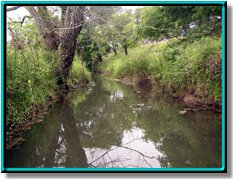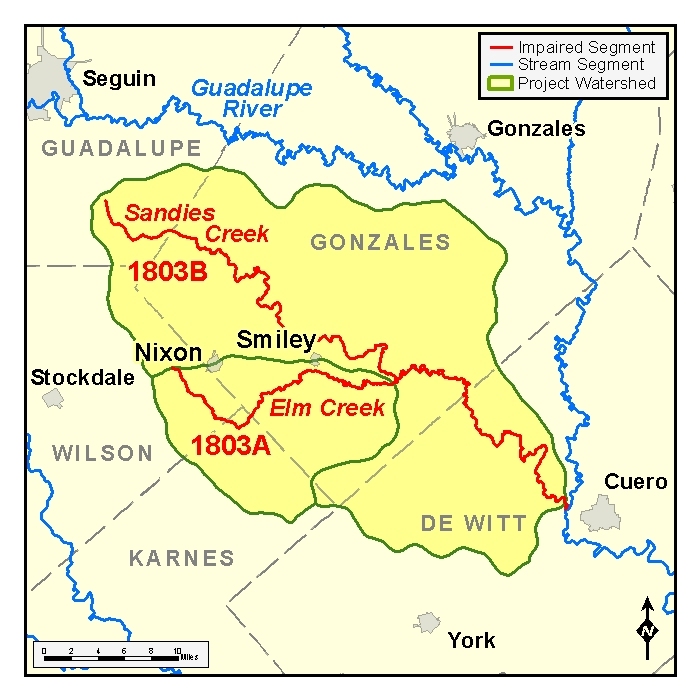Elm and Sandies Creeks
This is a completed project that evaluated high bacteria and low dissolved oxygen concentrations in Elm and Sandies creeks in south central Texas.
Counties: De Witt, Guadalupe, Gonzales, Karnes, Wilson
Parameters: Bacteria, dissolved oxygen
Basin: Guadalupe River
Segments: 1803A, 1803B
On this page:
- Background
- Description of Watershed
- Status
- Public Participation
- Project Reports
- Contact the TMDL Program
Background
In Elm Creek (1803A) and Sandies Creek (1803B) in south central Texas, water quality assessments in 1999 found elevated levels of fecal coliform bacteria and low concentrations of dissolved oxygen. TCEQ worked with the Guadalupe-Blanco River Authority and other regional stakeholders to assess the quality of the affected streams. The TMDL Program's South Central Texas Streams project identified the need to further assess the creeks and determine the most appropriate strategy to improve water quality in the creeks.
Bacteria are commonly found in the intestines of warm-blooded organisms such as humans, livestock, poultry, cats, and dogs. Bacteria from human and animal waste often indicate the presence of disease-causing microorganisms, which can pose a health threat to people who engage in contact recreation. Oxygen, which dissolves in water, is essential for the survival of aquatic life. While the amount of dissolved oxygen in water fluctuates naturally, various human activities can cause unusually or chronically low dissolved oxygen levels, which may harm fish and other aquatic organisms.
Description of Watershed
Elm Creek (Segment 1803A) originates west of Nixon in the eastern part of Wilson County, near the intersection of Wilson, Gonzales, and Karnes Counties. The stream flows eastward for approximately 24 miles. It converges with Sandies Creek just west of the Sandies’ crossing with FM 1116. Although Elm Creek flows past the southern outskirts of Smiley, it is essentially a rural waterway. The watershed is characterized by flat to rolling terrain dominated by hardwoods, pines, mesquite, and a variety of grasses.
Sandies Creek (Segment 1803B) originates in south-western Guadalupe County northwest of Smiley. The stream flows generally southeastward for approximately 65 miles until it joins with the Guadalupe River just west of Cuero in DeWitt County. Sandies Creek is essentially rural, though it flows past the northern out-skirts of Smiley and through the community of Westhoff. Like the watershed of Elm Creek, hard-woods, pines, mesquite, and a variety of grasses dominate the flat to rolling terrain around Sandies Creek.
Status
After reviewing the 2005 project assessment reports, stakeholders recommended that analysis of the use attainability of both the aquatic life and contact recreation uses was the most appropriate strategy for the creeks. No TMDLs were developed.
After conducting aquatic life use attainability analyses (ALUAAs), TCEQ proposed changing the aquatic life use standards in 2018 from high to intermediate for both Elm and Sandies Creek. EPA approved those changes in March 2021.
In 2008, based on additional data collected after 2004, TCEQ determined that Elm Creek was meeting its assigned contact recreation use and removed the bacteria impairment from the 303(d) list. No RUAA was therefore needed for Elm Creek. TCEQ has not begun the recreational use attainability analyses (RUAAs) for Sandies Creek.
Public Participation
TCEQ informed stakeholders about this project at public meetings and in print and electronic media. Meetings about TMDL projects are open to everyone.
Project Reports
Final reports from the assessment to determine the need for TMDLs, developed under interagency agreement under the supervision of the Texas Engineering Experiment Station.
- Final Report, Volume 1: Physical and Chemical Components
- Final Report, Volume 2: Biological and Habitat Components
Contact the TMDL Program
Please email tmdl@tceq.texas.gov and mention the Elm and Sandies Creeks project in the subject line. To find out more about the evaluation of the ALUAAs or RUAAs for both creeks, email the TCEQ Standards Group at standards@tceq.texas.gov. Or call the TMDL or the Standards teams at 512-239-6682.






 Back to top
Back to top